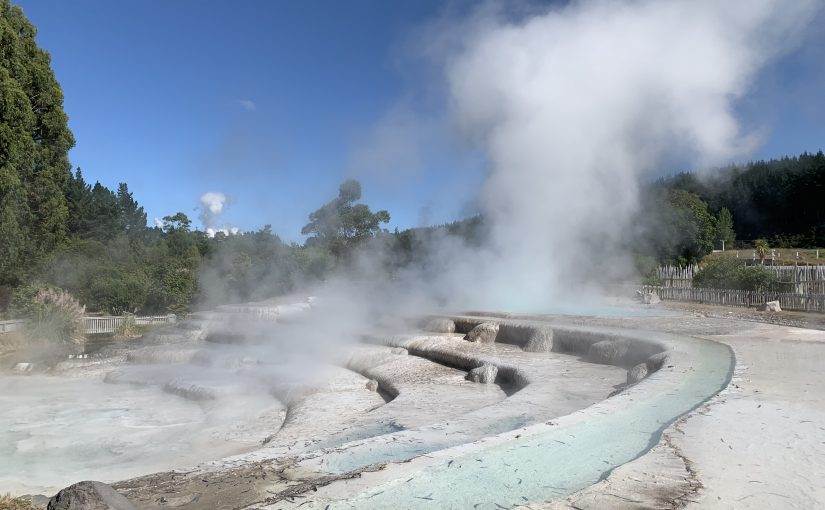One of the strangest things about North Island is suddenly coming across a patch of ground that’s smoking –

or hearing a glooping and plopping noise coming from a muddy puddle, which is bubbling away happily all by itself.
The volcanic hot springs are wonderful. You can either pay to go to the pools –

– where every pool is at a slightly different temperature, ranging from 36-40 degrees, and it’s a good idea to work your way up from warm to hot, rather than leap enthusiastically into the hot pool first.
Or if you want a freebie, just ask the locals where the nearest hot spring is. We found this one –

just off the main road between Taupo and Rotorua – a waterfall of wonderfully warm water in the middle of the bush … bliss.
And – even better – the geothermal water from these volcanic springs has a lot of health benefits. The Polynesian Pools in Rotorua are fed from two separate springs – the Priest Spring works wonders on your muscles and joints, and the Rachel Spring offers ageless beauty. I made sure that I spent an equal amount of time in both sets of pools as I couldn’t decide which benefit was most important to me.
And there’s also hot mud on offer at Hell’s Gate. The clay in the mud purifies and detoxifies the body, neutralises free radicals and stops ageing, according to the blurb – and so, of course I had to have a go. You clamber into the pool and scoop up the mud from the bottom and smear it all over you –

and then sit and wait for it to dry and draw all your impurities out –

then you wash all your impurities down the drain, and immerse your newly purified body in the sulphur water to keep the ageless beauty theme going. The only drawback to all these geothermal springs is the eggy whiff you get from all the sulphur, but that’s a small price to pay for ageless beauty in my book.
Hot Water Beach on the Coromandel Peninsula is another freebie – unless you count the $5 spade rental, which is essential to get the most out of the experience. There are a couple of hot water springs on the beach, and for two hours either side of low tide you can dig yourself a spa bath and wallow away to your heart’s content.

It’s a very strange sight; the beach is empty apart from the middle section where the springs are, which is full of people digging frantically. And there’s a skill to the digging too – you have to find a source of hot water to run into your hole, and a source of cold water too, as the spring water is too hot on its own. One group I spoke to were already on their third hole – rather like the three bears, the first hole had been too hot, and the second one too cold, so they were hoping that the third one would be just right.
Of course you don’t have to do the digging yourself –

– you can always bring your digging bitch with you.
And once your hole is at the correct temperature, you can lounge, wallow, chill, or catch up on your emails –

I’d never seen a geyser before either. I do remember learning about them in geography, but I don’t think I’d realised that the water that shoots out is hot – yet another example of my failing to pay attention in class.
We saw the tallest geyser in New Zealand, Pohutu, which gets to 100 feet high, and the one called the Prince of Wales because the shape it makes looks like the Prince of Wales’ Feather, apparently –

That’s the two of them behind me, with the Prince of Wales Feather growing out of my head. When they erupt there’s gurgling, hissing and sulphurous odours in spades.
Another by-product of geothermal activity is the silica terraces –

– the shape is so regular it looks like amphiteatre seating.
The pink and white silica terraces near Rotorua were considered the eighth wonder of the world, and were NZ’s biggest tourist attraction, until they were destroyed by a volcanic eruption in 1886.
And that’s really the biggest drawback of living on a fault line – the smell of sulphur and the risk of third-degree burns in a spa pool are nothing compared to the risk of an earthquake or a volcano flattening you, your home and your family at a moment’s notice. Perhaps there’s something to be said for hot water out of the hot tap in a country that’s well away from any earthquake zones.
